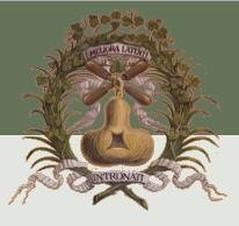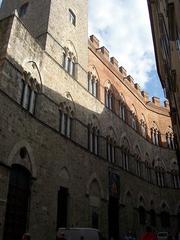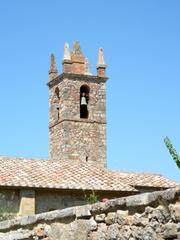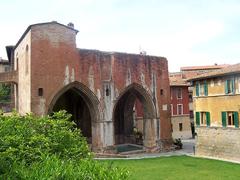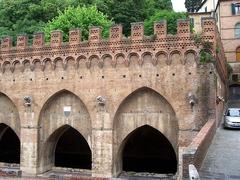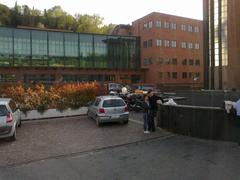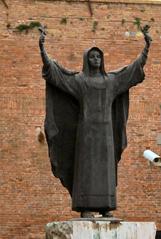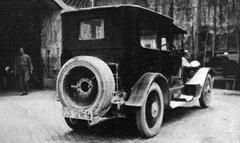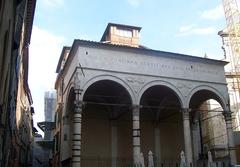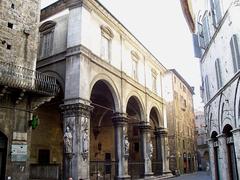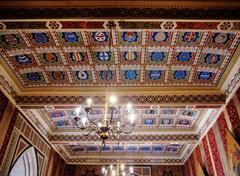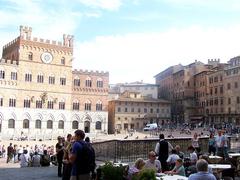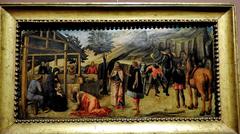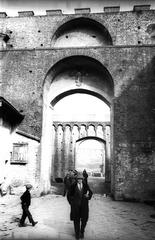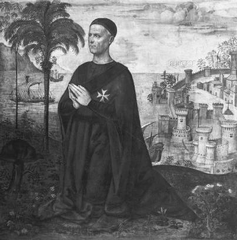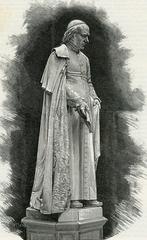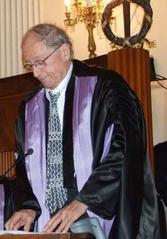Fonte di Follonica Visiting Hours, Tickets, and Travel Guide – Siena, Italy
Date: 14/06/2025
Introduction
Nestled within Siena’s storied medieval landscape, the Fonte di Follonica is a remarkable testament to the city’s ingenuity in water management, architecture, and urban life. Dating back to the early 13th century, this historic fountain—situated in the green valley east of Via di Pantaneto within the Contrada del Leocorno gardens—served not only as a vital water source but also as an industrial hub, defensive fortification, and social nucleus for the surrounding community. Its evolving role over the centuries, from serving fullers and cloth washers to providing refuge in times of conflict, mirrors the resilience and adaptability of Siena itself.
Today, the Fonte di Follonica enchants visitors with its medieval architectural features, including crenellated battlements and pointed arches, as well as its connection to the famed bottini—the subterranean aqueducts that are an engineering marvel of their time. Extensive restoration in recent decades has stabilized the site and transformed parts of it into the Museo dell’Acqua, offering educational exhibitions and guided explorations of Siena’s hydraulic heritage.
This detailed guide covers everything you need to know for a rewarding visit: history, architecture, cultural significance, practical visitor information, accessibility, travel tips, and nearby attractions. Whether you’re a history enthusiast, architecture lover, or casual traveler seeking the essence of Siena, Fonte di Follonica is a must-see landmark.
For official updates and planning resources, see La Diana Siena, Siena Guide, and Comune di Siena.
Table of Contents
- Introduction
- Historical Overview
- Architectural Features
- Cultural Significance
- Visitor Information
- Accessibility and Travel Tips
- Nearby Attractions & Suggested Itineraries
- Frequently Asked Questions (FAQ)
- Responsible Tourism & Safety
- Conclusion
- References
Historical Overview
Origins and Early Development
The Fonte di Follonica is first documented in 1226, its name deriving from the Latin “fullones”—cloth washers and fullers who used the site for textile processing (La Diana Siena). This highlights its original role as a vital water source not only for domestic needs but also for Siena’s artisanal economy.
Originally, the complex included two structures: a “fonte vecchia” (old fountain) and a “fonte nuova” (new fountain) (Wikipedia). Improvements between 1247 and 1253 included roof reconstruction and paving, underscoring its importance for the city’s infrastructure.
Medieval Expansion and Fortification
Following Siena’s victory at the Battle of Montaperti in 1260, the Fonte di Follonica was fortified with crenellated battlements and a small fort (the bicocca). This period also saw the construction of a public washhouse (lavatoio), elevating the fountain’s status as both a defensive and civic asset (La Diana Siena).
Decline and Rediscovery
After the Black Death in 1348, Siena’s population plummeted, leading to the fountain’s gradual abandonment. Attempts at restoration, such as the proposal by Francesco di Giorgio Martini in 1492, were never realized (Wikipedia). By the 16th century, landslides and neglect buried much of the structure. It narrowly escaped demolition in 1903, thanks to local advocacy.
Archaeological interest revived in the late 20th century, and a major restoration effort in 2003 led to the stabilization and partial reopening of the site (La Diana Siena).
Architectural Features
Defensive Design and Medieval Style
Fonte di Follonica’s robust stone walls, crenellated roofline, and pointed arches exemplify Siena’s approach to medieval civic architecture—a blend of utility and defense. Its three-basin layout (for drinking, animals, and laundry) reflects advanced thinking in public hygiene (Siena Guide).
Materials and Restoration
Constructed primarily from local travertine and limestone, the fountain’s Gothic character has been preserved through careful restoration. Recent interventions have included stabilizing masonry, cleaning stonework, and installing discreet lighting for nighttime visibility (Comune di Siena).
The Bottini Aqueducts
A defining feature is the connection to Siena’s underground bottini—kilometers of hand-dug tunnels that supplied water to the city. Guided tours of these aqueducts, accessible via the Museo dell’Acqua, reveal the extraordinary engineering behind Siena’s survival without a natural river (Siena Guide).
Cultural Significance
The Fonte di Follonica has always stood at the crossroads of Siena’s civic, economic, and symbolic life:
- Civic Role: Served as a vital communal water source, social gathering point, and symbol of neighborhood (contrada) identity.
- Economic Importance: Supported industries like cloth washing, tanning, and dyeing—central to Siena’s medieval prosperity (Siena Guide).
- Heritage Preservation: Now protected as part of Siena’s UNESCO World Heritage status, the fountain is maintained by both public authorities and local heritage groups like Associazione La Diana.
- Educational Value: The Museo dell’Acqua offers interactive exhibits, engaging both tourists and locals in Siena’s unique water history (Visit Tuscany).
- Community Life: The fountain remains a focal point during festivals and Contrada events, often adorned with banners and flowers.
Visitor Information
Visiting Hours
- Fonte di Follonica: Generally accessible 24/7 as a public site, but best visited during daylight hours for safety and visibility.
- Museo dell’Acqua: Typically open Tuesday–Sunday, 10:00 AM–6:00 PM. Check the official website for seasonal variations.
Tickets and Admission
- Fonte di Follonica: Free entry; no tickets required.
- Museo dell’Acqua: Modest entrance fee; discounts for students, seniors, and groups. Tickets available onsite or online.
- Guided Tours: Aqueduct (bottini) tours are available by prior booking through the museum.
Directions
- On Foot: 15–20 minutes from Piazza del Campo via Via di Pantaneto and the Contrada del Leocorno gardens. The walk is scenic but includes uneven, unpaved paths and gentle slopes (eco.museisenesi.org).
- Parking: Use San Francesco or Il Campo lots outside the city walls; walking required from there (discovertuscany.com).
- Public Transport: Siena’s center is pedestrianized; buses stop outside the walls.
Accessibility
- Terrain: Not wheelchair-accessible; uneven, sometimes muddy paths.
- Facilities: No restrooms, shops, or cafés at the site; nearest amenities are in the city center.
- Signage: Limited; download or print guide materials in advance.
Accessibility and Travel Tips
- Wear sturdy shoes suitable for uneven ground.
- Bring a refillable water bottle—the fountain’s water is potable.
- Visit early or late in the day for the best light and fewer crowds.
- No climbing or bathing in the fountain—preserve this historic site for others.
- Bring coins for public restrooms in Siena (Savoring Italy).
Nearby Attractions & Suggested Itineraries
- Fontebranda: Siena’s most famous medieval fountain.
- Piazza del Campo: Heart of Siena and site of the Palio horse race.
- Siena Cathedral (Duomo): Masterpiece of Italian Gothic architecture.
- Convent of San Francesco: Directly above the Fonte di Follonica.
- Orto de’ Pecci: Community garden and café nearby.
Suggested itinerary: Morning visit to Fonte di Follonica, stroll through Siena’s historic fountains, lunch at Orto de’ Pecci, and afternoon at the Duomo or Piazza del Campo.
Frequently Asked Questions (FAQ)
Q: What are the Fonte di Follonica visiting hours?
A: The fountain is open and accessible year-round, 24 hours a day, though daylight is recommended. The Museo dell’Acqua is generally open 10:00 AM–6:00 PM, Tuesday–Sunday.
Q: Is there an entry fee?
A: No, the fountain is free to visit. The Museo dell’Acqua charges a modest fee.
Q: Is the fountain accessible for wheelchairs?
A: No, due to uneven, unpaved terrain.
Q: Can I drink the water?
A: Yes, the fountain provides potable water.
Q: Are guided tours available?
A: Yes, for both the museum and bottini aqueducts. Book in advance.
Q: How do I reach the fountain from Siena’s center?
A: Walk 15–20 minutes from Piazza del Campo via Contrada del Leocorno gardens.
Responsible Tourism & Safety
- Preservation: Do not climb or sit on the ruins; avoid disturbing masonry.
- Litter: Carry out all trash; there are no bins onsite.
- Respect Contrada traditions: The area is significant for the Contrada del Leocorno—be mindful during local events.
- Safety: The area is safe but secluded; use standard precautions, especially at night.
Conclusion
The Fonte di Follonica encapsulates Siena’s enduring medieval spirit, blending architectural beauty, technological ingenuity, and vibrant community life. Its tranquil valley setting, rich historical layers, and proximity to Siena’s most celebrated monuments make it an essential stop for any visitor. Restoration and responsible tourism ensure that this unique site continues to inspire and educate, connecting present-day travelers with the city’s storied past.
Plan your visit with up-to-date information from official tourism portals, and consider using the Audiala app for curated walking tours and interactive maps. By respecting the site’s heritage and embracing sustainable practices, you help preserve Fonte di Follonica for generations to come.
References and Further Reading
- Fonte di Follonica: Visiting Hours, Tickets, and History of Siena’s Historic Fountain (La Diana Siena)
- Visiting Fonte di Follonica in Siena: Hours, Tickets, History, and Travel Tips (Siena Guide)
- Fonte di Follonica Visiting Hours, Tickets & Guide to Siena’s Historic Fountain (Comune di Siena)
- Fonte di Follonica Visiting Hours, Tickets & Visitor Guide | Siena Historical Sites (Eco Musei Senesi)
- Visit Tuscany: Not Only Sea - 5 Things to Do in Follonica (Visit Tuscany)
- Siena travel tips (Savoring Italy)
- Siena tourist info (discovertuscany.com)
- Siena best things to do (fullsuitcase.com)
- Siena medieval fountains (siena-agriturismo.it)
- Siena events (sienaitalytours.com)
